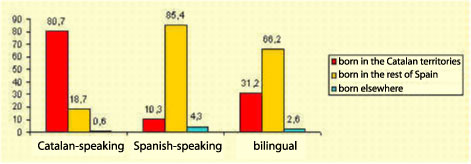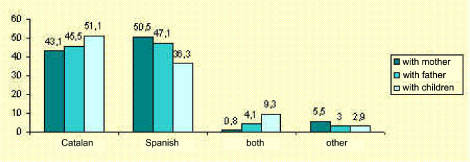
| Sociolingüística catalana |
| Linguistic uses and identity in
Catalonia, by Albert Fabà, Olga Gàlvez, Joan Manrúbia and Noemí Ubach |
||||
| CONTINUA |
| Thus,
if we accept the basis of this comparison, during the last quarter of this century, the
number of Catalan-speakers has remained fairly stable, and may even have increased
slightly. Given the differential birth rate of both groups, this maintenance can only be
explained if a proportion of those who considered Spanish (or Spanish and Catalan) to be
their domestic language, or the children of these individuals, have adopted Catalan as
their exclusive language, as shown in Figure 2.Figure 2. Linguistic identity and
mother's place of birth. 2000. Percentages
As regards the appearance of the bilingual group, everything points to it being a latent phenomenon present twenty-five years ago. Although it is not a recent happening, it is expanding gradually whilst, at the same time, the group of individuals who consider Spanish to be their sole language is decreasing. (4) From a sociolinguistic point of view, this bilingual sector may not seem very significant, particularly insofar as it concerns the use of Catalan. Even more so, if we remember that this identity is not very well-established. However, our data indicates that this is not the case: when the questions on linguistic use and linguistic identity are intersected, important differences are revealed between Spanish-speakers and bilingual individuals in terms of the use of languages in Catalonia, as we shall see later. Let us begin with a panoramic view using Figure 3. Figure 3. Language spoken with father, partner and children. 2000. Percentages
All too often, we are not fully aware of the tremendous effect of migrations on the recent history of Catalonia. These figures serve to remind us. The clearest indication of this is the fact that, in Catalonia, the majority group in terms of the language used for communicating with both the mother and father, is that of Spanish-speaking citizens. We are talking about 50% of the population, or even a little more, almost ten points difference with those that communicate in Catalan. (5) Although the figures that we will discuss later are relatively positive in this regard –telling us that we have progressed over recent decades– the use of Catalan is still very limited and by no means satisfactory. No particularly remarkable changes occur in the next block - the language spoken with the partner. Thus, it is only when we reach the third block –the language spoken with children– that we see significant changes in domestic language. Here, Catalan finally becomes the progressing language and the most commonly selected option. The bilingual option, on the other hand, is proportionally more important than in the other two cases. (6) Thus, as in the previous section, it would appear that a certain language gain has occurred in terms of this transgenerational aspect. We can confirm this by intersecting the language that interviewees spoke with their fathers and that used with their children (if they have any). See Figure 4. Figure 4. Generational evolution of language use: language spoken with father and language spoken with children. 2000. Percentages
|


